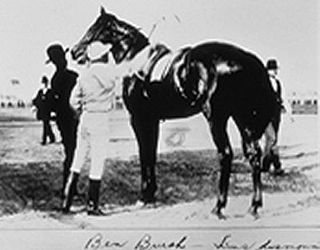James A. McLaughlin was an American National Champion jockey in Thoroughbred racing and a Hall of Fame inductee.

Hindoo (1878–1901) was an outstanding American Thoroughbred race horse who won 30 of his 35 starts, including the Kentucky Derby, the Travers Stakes, and the Clark Handicap. He later sired Preakness Stakes winner Buddhist and Belmont Stakes winner and Leading sire in North America Hanover.

Hanover (1884–1899) was a champion American Thoroughbred racehorse, who won his first 17 races. He was the last American stallion to be the leading sire in North America for four consecutive years until Bold Ruler achieved the feat in 1965.

Ben Brush (1893–1918) was a champion American Thoroughbred racehorse who won the 1896 Kentucky Derby.

Gravesend Race Track at Gravesend in Brooklyn, New York was a Thoroughbred horse racing facility that opened in 1886 and closed in 1910. The track was built by the Brooklyn Jockey Club with the backing of Philip and Michael Dwyer, two wealthy racing stable owners known as the Dwyer Brothers. Philip, the controlling shareholder of the Brooklyn Jockey Club, served as its president.
Tremont (1884–1899) was an American Thoroughbred racehorse who, according to the New York Racing Association, was acclaimed by 19th-century Thoroughbred horse racing historians as the best two-year-old ever bred in the United States. He was undefeated in thirteen starts at age two, but never raced again.
The United States Hotel Stakes was an American Thoroughbred horse race run annually in the late summer or early autumn until 1955 at Saratoga Race Course in Saratoga Springs, New York. It was run on dirt over a distance of six furlongs. Raced in the pre-grading era, for most of its existence the race was one of the premier shorter distance competitions for two-year-old horses in the United States.
Philip Joseph Dwyer was an American businessman from Brooklyn, New York and prominent owner of Thoroughbred racehorses and racetracks. Along with his younger brother, Michael F. Dwyer, he made a fortune in the meat packing industry, supplying butcher shops, eating establishments and hotels.
Michael F. Dwyer (1847–1906) was an American businessman and prominent owner of Thoroughbred racehorses and racetracks from Brooklyn, New York. He and older brother Philip made a fortune in the meat packing industry, supplying butcher shops, eating establishments and hotels.

Leonatus was an American Thoroughbred racehorse who won the 1883 Kentucky Derby.
The Latonia Derby was an American Thoroughbred horse race run annually from 1883 through 1937 at Latonia Race Track in Latonia, Kentucky. Open to three-year-old horses, for its first 52 years the Latonia Derby was contested at a mile and a half then in 1935 the distance was shortened to a mile and a quarter. It was run as the Hindoo Stakes from inception in 1883 to 1886 in honor of the Kentucky-bred U.S. Racing Hall of Fame horse, Hindoo. The race usually attracted the Kentucky Derby winner; it became so popular that in 1912 a motion picture was made by Independent Motion Picture Co. entitled Winning the Latonia Derby, featuring silent film star King Baggot.

Hardy Alonzo Campbell Jr. was an American Thoroughbred horse racing trainer and Standardbred horse owner.
Virgil (1864–1886) was an American thoroughbred racehorse that was bred in Kentucky by Hyman C. Gratz. He was a brown to dark bay stallion, was approximately 16 hands high and had a prominent white star on his forehead.[2] His sire, Vandal, was the second leading sire of the time, behind the great Lexington. Virgil was a direct descendant of the thoroughbred foundation sire Herod and was the leading sire in the United States in 1885.
The Bard (1883–1907) was an American Champion Thoroughbred racehorse. He was the most popular horse of his day and one who raced and beat many leading American horses.
The Coney Island Derby was an American Thoroughbred horse race run annually between 1880 and 1888 at Sheepshead Bay Race Track in Sheepshead Bay, Brooklyn, New York. Open to three-year-old horses, it was contested at a mile and a half on dirt.
Rayon d'Or (1876–1896) was a French Thoroughbred racehorse and Champion sire in the United States. Bred by Frédéric Lagrange at his Haras de Dangu stud farm in Dangu, Eure, he was sired by Flageolet whose wins included the Prix Morny (1872), Goodwood Cup (1873) and Jockey Club Cup (1873) and whom Rayon d'Or would help make the Leading sire in Great Britain and Ireland in 1879. Rayon d'Or's dam was the good producing mare Araucaria, sired by Ambrose. Araucaria was the last foal of the mare Pocahontas whom Thoroughbred Heritage says is "one of the most influential thoroughbreds of all time, male or female."
Running Water was an American Champion Thoroughbred racemare.
The First Special Stakes was an American Thoroughbred horse race run between 1886 and 1909 at Gravesend Race Track in Gravesend, on Coney Island, New York. The race was run on dirt at a distance of one and one-quarter miles and was open to horses of either sex age three and older since 1887.
The Junior Champion Stakes was a Thoroughbred horse race for two-year-olds of either sex run from 1884 through 1893 at the Monmouth Park Racetrack in Eatontown, New Jersey. Run on dirt, it was contested over a distance of six furlongs.
Sir Dixon (1885-1909) was an American Thoroughbred racehorse best known for winning the 1888 Belmont Stakes.






